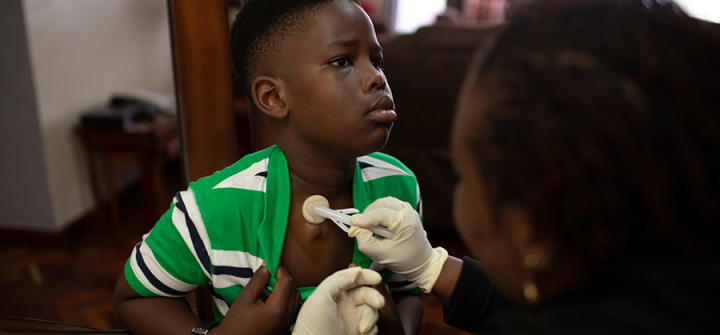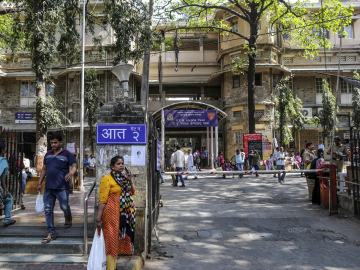Hemophilia’s Crippling Cost
NAIROBI, KENYA – After months of traversing Kenya on buses to get a bruised and constantly bleeding baby to the country’s best hospitals, and after lost tests, delayed results, and wrong diagnoses, Maureen Miruka finally learned in 2001 that her son had hemophilia.
9-month-old Jose had a severe form of the hereditary and deadly blood disorder caused by a lack of proteins needed to form clots and stop bleeding. Miruka had previously lost a baby after a difficult birth, later suspecting the child’s death was caused by hemophilia. The tragedy made her even more determined to keep Jose alive. To do that, she needed the standard treatment for hemophilia: blood clotting medicines called factor concentrates that quickly stop bleeds and reduce swellings.
“All of my earnings, and my mother’s, went into maintaining my son,” she said.
A PhD student with a government job, Miruka was much better off than most Kenyans, but even she didn’t have the resources to manage one of the world’s most expensive health conditions. Things got worse after her husband's family learned hemophilia is passed down through women.
“I divorced with my [husband] because of all that kind of acrimony and blame that, ‘I brought this upon the family, I brought this gene and disappointment on the family,’” she said. “His mother actually told me to my face, ‘If these are the kind of children you get, you’re better off adopting.’”
Caring for Jose alone, Miruka usually only could afford doses of expired factor, which are less potent but still worked better than infusing him with others’ blood. Frequent hospital visits for Jose meant that sometimes family had to come with deeds to their property or cars to guarantee that the bills would be paid.
In developed countries, free or subsidized access to clotting factor—which the WHO considers an essential medicine—is available on demand. It is even used preventively to allow patients to lead mostly normal lives. In countries like Kenya, however, the cost of lifesaving factor is a luxury most can’t afford. Child doses can cost from $350 for a mild case to more than $1000 for a severe case or incident. For adults, those costs can more than double. The annual cost to properly treat severe cases can reach hundreds of thousands of dollars per year. Up to 770,000 people are believed to have hemophilia—80% of whom live in low and middle-income countries.
While hemophilia affects people from all racial and ethnic groups, access to care and treatment is not as equitably distributed. How long and how well you live with hemophilia is essentially a postal code lottery, said Glenn Pierce, World Federation of Hemophilia vice president for medical. “The incidence of hemophilia is about the same throughout the world, but clearly survival is dependent on clotting factor concentrates—the availability of those and the quantity—to manage bleeding episodes,” Pierce said.
In Western Europe and North America, life expectancies for severe hemophiliacs have risen from age 20 in 1950 to around normal today. This is due to having sufficient clotting factor to provide on-demand care for bleeds and full prophylaxis to prevent them. If bleeds are treated quickly and patients are infused 2-3 times a week with factor, people with hemophilia can live a relatively normal life.
Yet low and middle-income countries struggle to provide enough factor for their populations. Most sub-Saharan African countries, for example, need at least 100 times more clotting factor than they have to properly treat people with hemophilia, said Pierce. “We need to advocate to governments to purchase clotting factor to provide at least minimal care—and recognize that even that minimal care is a very long distance away from the state-of-the-art care that patients in the developed world are able to access.”
Four years ago, Dr. Kibet Shikuku, a hematologist and chairman of the Kenya Haemophilia Association, calculated that the amount of factor that Kenya as a country was getting was equivalent to the factor used to treat 2 patients in a developed country well.

Dr. Kibet Shikuku at the Kenyatta National Hospital in Nairobi. Image by Will Swanson for GHN
Things have improved in recent years, however, as foreign donations have helped Kenya to amass about 30% of the factor it needs, Shikuku said. And developing countries have benefited from a 2014 pledge by 2 companies—Bioverativ and Sobi Sobi—to provide 1 billion units of factor over 10 years through the WFH and patient-led organizations like the KHA. Spanish company Grifols and others have also pledged additional donations.
However, Shikuku believes more permanent solution beyond philanthropy and donated medicines is needed. “You cannot manage a program through donations and this has made us now call upon the government to try and step in so we can have treatment readily available,” he said.
* * *
Jose Miruka died in 2006 after surgery to solve ongoing respiratory issues. Miruka was told he died of cardiac arrest, but she later discovered that Jose had developed antibodies to the clotting factor he was given before the operation. It is usually detected in tests, but these were not done at the private hospital where he was taken nor were drugs available to treat patients who develop inhibitors to the medicine.
“We lost him just 2 weeks shy of his 6th birthday and that was harrowing,” Miruka said, “but then after that it was like: ‘You know what? Enough’s enough with hemophilia care in Kenya.’”
Miruka then established the Jose Memorial Haemophilia Society, which dispenses factor donated by manufacturers or individuals to the American charity Project Share. A sister charity, Save One Life, helps families with the crippling costs of hemophilia, including offering patients college scholarships and small business grants. It also supports families with direct financial assistance to pay for funerals or clear hospital bills to release children held there. Miruka has another son with hemophilia, 10-year-old Ethan, and he gets free prophylactic care that would otherwise cost $200,000 a year through insurance provided by her job at American charity, she said.
WFH is calling on pharmaceutical companies to reduce the price of factor medicines, which cost much less to make than their retail price. Why costs aren’t reduced for low- and middle-income countries flummoxes Pierce. “Manufacture of these drugs is cheap relative to the prices that are charged for them. But clearly, most of the countries in this space do not have the ethical or moral imperative to do it.”
Countries like Brazil and Georgia have made progress due to government investment in factor. But in poorer countries with many competing issues and few resources, buying expensive treatment for relatively few people with a rare condition is a hard sell. In Kenya, the KHA is petitioning parliament to discuss hemophilia and trying to find the estimated 4,500 missing Kenyans with hemophilia to strengthen its pleas for free health care.
Miruka spent years trying to lobby the government for help to save children through JMHS before giving up to concentrate on arranging foreign donations of factor. From a rent-free Nairobi office next to a private hospital, Miruka pays for JMHS staff with local donations. She also relies on donations to equip the office—and even gave her own refrigerator to store medications.

Maureen Miruka at her home in Nairobi. Image by Will Swanson for GHN.
She still gets calls from the biggest public referral hospital in East Africa, pleading for factor because they have gone without for weeks. “For me, it’s tragic that a medical doctor will call me for factor, when a doctor should ask the government,” Miruka said.
Even as she serves as a sort of clearinghouse for donations, she acknowledges it’s not a sustainable solution that government will have to get involved. She also knows well that more support is needed for families struggling with the crippling financial, emotional and logistical strain of hemophilia.
“My experiences and other mothers’ experiences of losing young children is that it is just such a lonely experience,” Miruka said.
Read Part I of the GHN series “‘We are Many’: The Race to Treat Hemophilia in Kenya” here.
Join tens of thousands of subscribers who rely on Global Health NOW summaries and exclusive articles for the latest public health news. Sign up for our free weekday enewsletter, and please share the link with friends and colleagues: Subscribe to GHN
Ethan Miruka, 10, receives blood clotting medicine every 48 hours, which allows him to carry on a normal life without regular visits to the hospital. Image by Will Swanson for GHN




